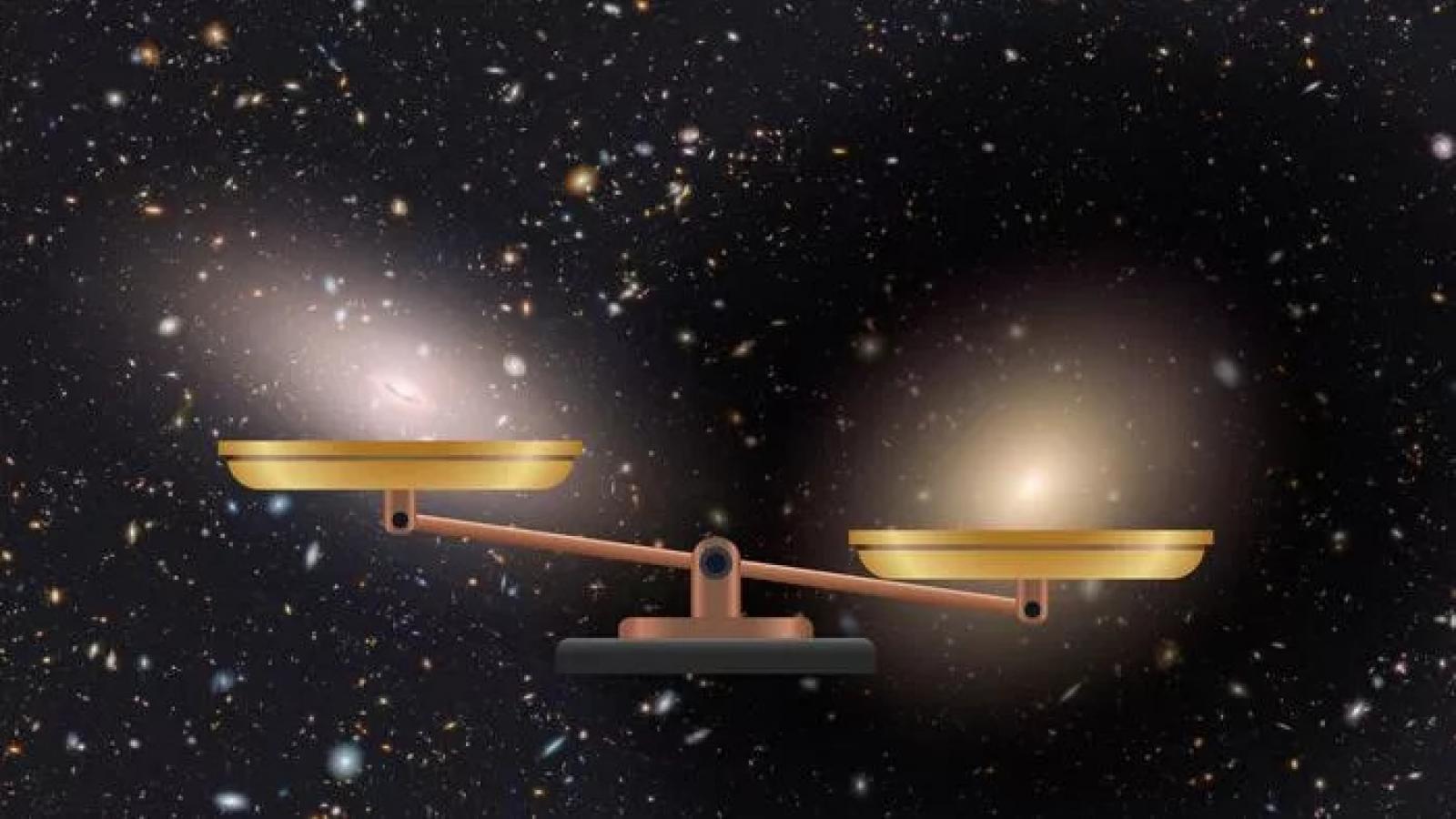Massive galaxy with no dark matter is a cosmic puzzle

Our picture of cosmic evolution could be thrown into doubt by the discovery of a massive galaxy that seems to lack dark matter.
Dark matter, which accounts for around 85% of the matter in the universe, seems to be absent from the galaxy NGC 1277, part of the Perseus Cluster of galaxies. The galaxy, located 240 million light-years from Earth, is the first Milky Way-sized conglomeration of stars, planets, dust and gas found to be missing dark matter.
"This result does not fit in with the currently accepted cosmological models, which include dark matter," the leader behind the discovery and University of La Laguna researcher Sebastién Comerón said in a statement.
Dark matter is effectively invisible because it does not interact with light like the everyday matter that composes stars, planets, and us. Its presence can be inferred by its gravitational interactions, however. The existence of this shadowy substance was first posited when astronomers observed massive galaxies rotating so fast they would fly apart if it weren't for the gravitational influence of some unseen mass holding them together.
This fact resulted in scientists theorizing that all large galaxies are wrapped in an envelope of dark matter, and this has become an important assumption in the development of theories of galactic evolution. But the discovery of a galaxy that appears to haven no dark matter challenges that assumption.
Examining an anti-social relic galaxy
Considered a cosmic relic, NGC 1277 is unusual among galaxies because it has had little interaction with other surrounding galaxies. Galaxies like this are considered to be the remains of giant galaxies that existed in the early universe. As such, these relic galaxies are essential in helping astronomers to understand how the first galaxies formed.
To assist in this line of inquiry, Comerón and colleagues observed the relic galaxy NGC 1277 with an instrument called an integral field spectrograph. This allowed them to map the motion of the galaxy and determine its mass and how that mass is distributed.
This revealed that the distribution of NGC 1277's total mass — which should include dark matter — was the same as the distribution of the mass of its everyday matter contents, in other words, stars, dust, gas and planets. That means that within the galaxy's radius, there can't be a dark matter content any greater than 5%, but the findings are more consistent with a complete absence of dark matter in NGC 1277.
This is surprising, as the currently favored models of cosmic evolution including the standard model of cosmology, suggest NGC 1277 should be comprised of between 10% and 70% dark matter.
"This discrepancy between the observations and what we would expect is a puzzle, and maybe even a challenge for the standard model," team member and University of La Laguna researcher Ignacio Trujillo said.
Zoomed-out Hubble view of NGC 1277, which lies near the center of the Perseus cluster of over 1,000 galaxies, located 240 million light-years away from Earth. (Image credit: M. Beasley(Instituto de Astrofisica de Canarias)/P. Kehusma/NASA/ESA)
Where did relic galaxy's dark matter go?
The scientists behind this revelation have a few ideas about why NGC 1277 is so deficient in dark matter.
"One is that the gravitational interaction with the surrounding medium within the galaxy cluster in which this galaxy is situated has stripped out the dark matter," team member and University of La Laguna researcher Anna Ferré-Mateu. "The other is that the dark matter was driven out of the system when the galaxy formed by the merging of protogalactic fragments, which gave rise to the relic galaxy."
The team isn't totally satisfied with either explanation and will, therefore, continue investigating NGC 1277 with the William Herschel Telescope (WHT) at the Roque de los Muchachos Observatory on the Canary Island of La Palma.
If these future investigations confirm this relic galaxy lacks the universe's most mysterious form of matter, the scientists think this won't challenge the existence of dark matter altogether. Conversely, the team believes it would challenge alternatives to dark matter models, so-called modified gravity theories.
"Although the dark matter in a specific galaxy can be lost, a modified law of gravity must be universal; it cannot have exceptions," said Trujillo. "So a galaxy without dark matter is a refutation of this type of alternative to dark matter."
Conclusive answers will have to wait, though, Comerón acknowledged. "The puzzle of how a massive galaxy can form without dark matter remains a puzzle," the scientist concluded.
The team's research is published in the journal Astronomy and Astrophysics.
Join our Space Forums to keep talking space on the latest missions, night sky and more! And if you have a news tip, correction or comment, let us know at: community@space.com.
Breaking space news, the latest updates on rocket launches, skywatching events and more!
Contact me with news and offers from other Future brandsReceive email from us on behalf of our trusted partners or sponsors
By submitting your information you agree to the Terms & Conditions and Privacy Policy and are aged 16 or over.

Robert Lea
Contributing Writer
Robert Lea is a science journalist in the U.K. whose articles have been published in Physics World, New Scientist, Astronomy Magazine, All About Space, Newsweek and ZME Science. He also writes about science communication for Elsevier and the European Journal of Physics. Rob holds a bachelor of science degree in physics and astronomy from the U.K.’s Open University. Follow him on Twitter @sciencef1rst.
photo : An illustration shows a conventional galaxy wrapped in a halo of dark matter and NGC 1277 which displays a lack of this mysterious form of matter (Image credit: Gabriel Pérez Díaz (IAC). Image of NGC 1277: NASA, ESA, and M. Beasley (IAC). Image of ESO 325-G004: NASA, ESA, and The Hubble Heritage Team (STScI/AURA); J. Blakeslee (Washington State University))
- Se connecter ou s'inscrire pour publier un commentaire
- 37 vues
Connexion utilisateur
Dans la même rubrique
06/12/2025 - 12:25
13/11/2025 - 10:20
de Philippe RICHARD
27/10/2025 - 12:20
URGéo-URBATER, Université d'État d'Haïti, Agence Kannh et le bureau d'étude et de conseils TCGNRG
22/10/2025 - 19:03
16/09/2025 - 15:48
Commentaires récents
L'antisionisme se paie cash, ma belle !
HOU LA !
Albè
15/12/2025 - 12:34
Me dit pas que t'es de la même trempe que Babette de Rozières ou Christine Kelly ! Lire la suite
L'antisionisme se paie cash, ma belle !
Albè....
Frédéric C.
15/12/2025 - 12:11
...je voulais dire "sophisme". Mais je ne suis pas créoliste alors bon... Lire la suite
L'antisionisme se paie cash, ma belle !
"SOFIS" ???
Albè
15/12/2025 - 11:58
Sa sa lé di ? Man gadé adan pliziè diksionnè kréyol mé man pa wè mo-tala !
Lire la suiteL'antisionisme se paie cash, ma belle !
No comment, Albè. Man boufi épi-w
Frédéric C.
15/12/2025 - 11:46
Ou ka plen mwen épi sé sofis-ou a!
Lire la suiteL'antisionisme se paie cash, ma belle !
NON? FREDERIC...
Albè
15/12/2025 - 09:59
Votre truc n'est ABSOLUMENT PAS du deuxième degré. Lire la suite
Top 5 des articles
Aujourd'hui :
- L'antisionisme se paie cash, ma belle !
- Les îlots Matthew et Hunter au cœur d’un conflit entre la France et le Vanuatu
- Bénin : quand l'activiste Kémi Séba s'emmêle les pédales
- Kréyolad 1105: Vizit flap flap
- Police Charge Martinique Passenger for Drug Importation; Gun and Ammunition Recovered in South
Depuis toujours :
- Tous les présidents et premiers ministres de la Caraïbe sont vaccinés
- L'intolérable appauvrissement intellectuel et culturel de la Guadeloupe et dans une moindre mesure de la Martinique !
- LETTRE OUVERTE AU 31ème PREFET FRANCAIS DE MARTINIQUE
- L'arrière-grand-père maternel de Joan Bardella était...algérien
- Les triplement vaccinés contre le covid ne bandent plus





